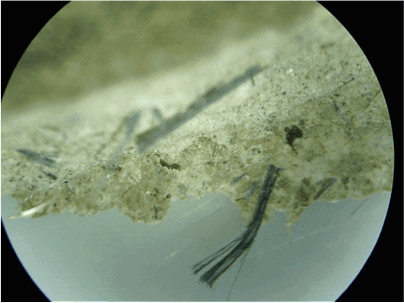
Blue asbestos (Crocidolite) visible in asbestos cement
Most people know very little about asbestos. It’s only when they’re halfway through renovations and realise they’re dealing with the deadly material, or tragically when they or someone they know is suffering from an asbestos-related disease, that they start looking for information.
It’s vital that if you’re thinking about renovating your home – or even doing simple maintenance work – you arm yourself with enough facts and knowledge to protect yourself and your family.
Over the last 20+ years of inspecting asbestos in buildings, we’ve heard all the common questions. Here are a few of them.
Is asbestos still a danger today?
Yes! The reality is that two thirds of the houses in Australia today will have had asbestos used in their construction in some form. That means there’s a significant chance that there is still asbestos present in your home today. But don’t panic – asbestos-containing materials are generally safe as long as they are well-maintained. It’s only once damaged, by external factors like weather conditions or human interference, that asbestos dust is produced, releasing the dangerous fibres into the air.
How much exposure to asbestos is dangerous?
Several studies have tried to answer this question – unfortunately, there is still no definitive answer.
There have been autopsies of deceased individuals who had asbestos embedded in their bodies, but who did not suffer from asbestos-related disease.
Conversely, there are reports of minimal or apparently single exposures to asbestos that have caused disease and even death.
There are also contributing factors such as smoking that make the likelihood of acquiring an asbestos-related disease that much greater. As with most things, it’s all about managing the risk. The less exposure, the less risk!
How do I tell whether or not it is asbestos?
It can be hard to identify asbestos. For example, fibrous cement sheeting made in the early 1980s with asbestos is visually identical to that made in the mid 1980s without asbestos.
The only definitive way to tell is to do a sample analysis through microscopic examination. Vinyl tiles and sealants often require further testing using X-ray diffraction or scanning electron microscopy to prove asbestos content.
Although studies are unsure about how much exposure to asbestos is dangerous, one thing is very clear: asbestos exposure gives no second chance (like touching a high voltage cable) and the breathing in of asbestos dust cannot be reversed. If you are unsure of the presence of asbestos, do not touch it and have it checked before proceeding further.
Our book Identifying Asbestos in your Home was written to help homeowners and renovators take the first steps towards identifying asbestos. You can get a copy of the book here.
